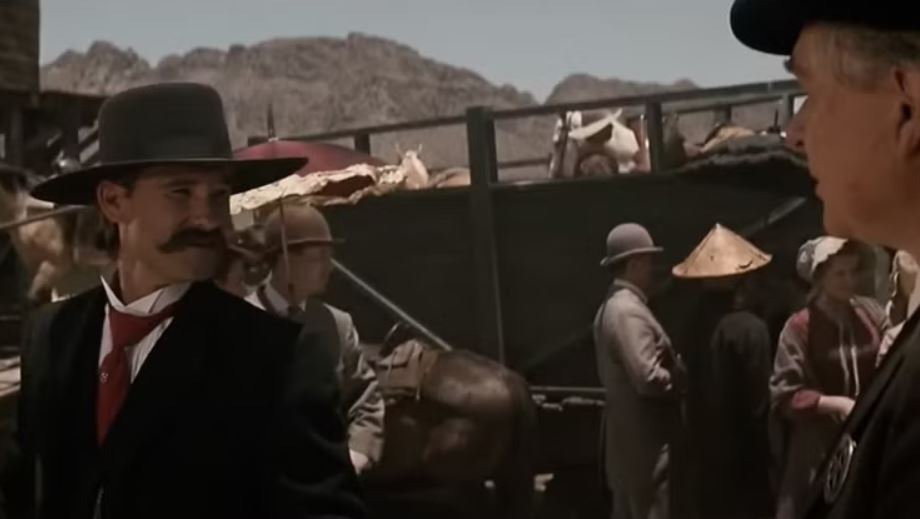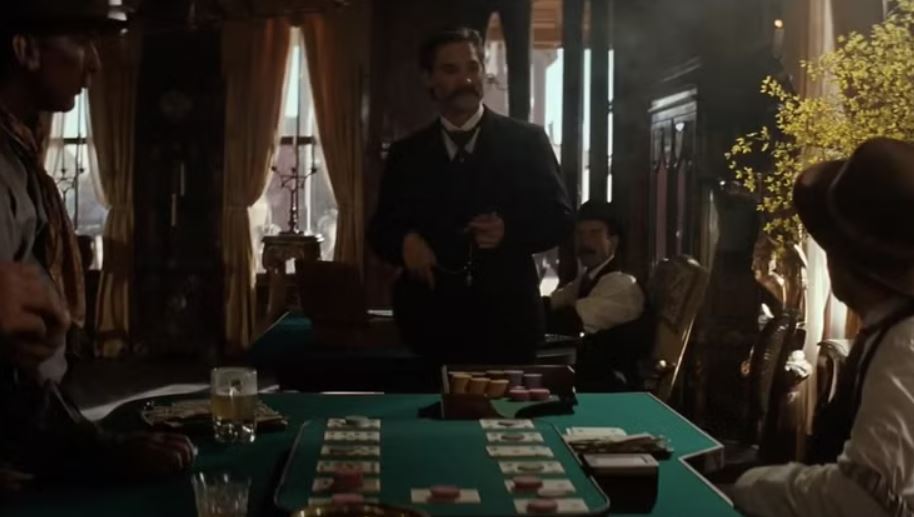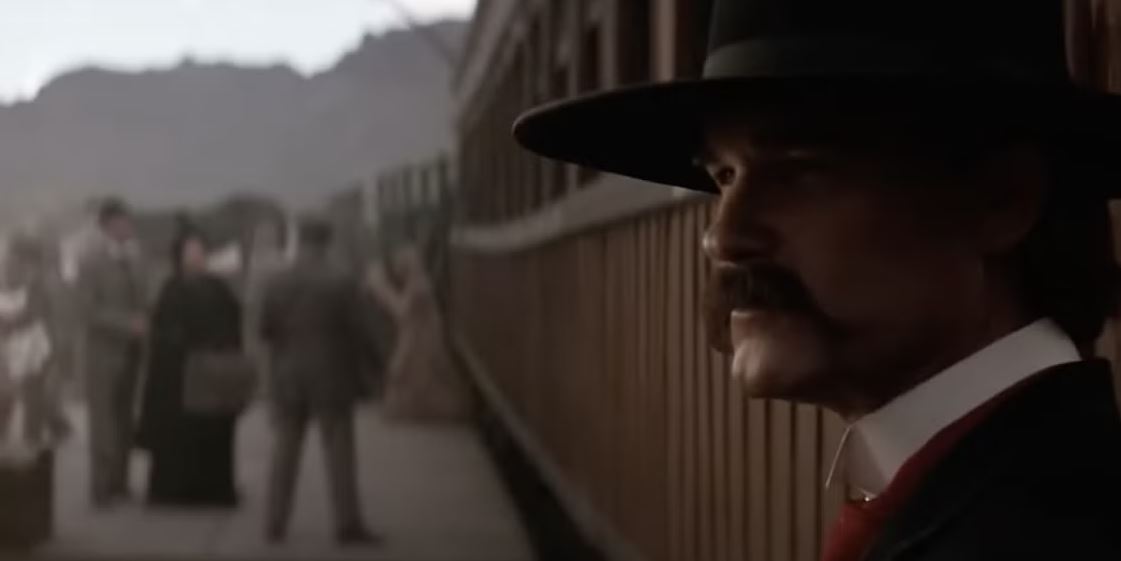Tombstone is lauded for its nuanced portrayals of historical figures from the Old West. In one of the film’s best character introductions, the complexities of the famous gunslinger, Wyatt Earp, are perfectly captured. The film depicts both his admirable qualities and less heroic attributes in an exploration of what it means to be a lawman in a lawless land. The film portrays Wyatt Earp’s life in Arizona, after leaving Kansas and ending his time as a US Marshal. While trying to build a new life free from the stresses of law enforcement, Earp can’t help but become entangled with the growing threat posed by the Cowboys, a gang of ruthless criminals terrorizing the West. Wyatt Earp’s transition from avoidant bystander to a merciless enforcer of the law explores the origins of violence and the repercussions of indulging in dark impulses.
In Tombstone, Wyatt Earp is haunted by the feeling that death follows him like a shadow and touches everyone around him. This fear coexists with a ravenous bloodlust that lurks inside Earp. Tombstone shows the effects of a brutal environment on the human spirit. The film’s character introduction to Earp perfectly sets the stage for a story of inner turmoil and facing demoralizing odds.
At First, Earp Doesn’t Seem Like the Bringer of Death
Earp’s Avoidance of Law Enforcement Reveals a Deep-Seated Fear
As the Cowboys terrorize a wedding party in the beginning of Tombstone, a local priest warns them of death riding a pale horse, coming for their gang. From the moment Kurt Russell’s Wyatt Earp first steps off a train, he actively avoids any requests to come out of retirement and get involved with law enforcement. Tombstone provides a less romanticized version of the lionized historical figure, who has become more myth than man over the years. The real life Earp was a hustler, involved in multiple business ventures in order to profit off of the frontier. The film uses Earp’s avarice to emphasize his desire to escape the violence and loss he experienced as a lawman in Kansas.
During these early scenes in Tombstone, the audience might think the West was won through slapping. Earp limits himself to using stern words and hard slaps to assert his dominance over the town of Tombstone and allow his family to take control of the local businesses. This at first glance seems like a far cry from the priest’s prophecy of doom, but Earp’s aversion to calls for help, and persistence in building a new life, indicate an intense fear of predestined violence.

The Earps’ New Life Comes at a Price
Chaos Caused by the Cowboys Pulls Earp Out of His Dreams of a Quiet Existence
As the story of Tombstone progresses, Earp quickly learns that the new, prosperous life he desires comes at the price of other people’s safety. The Cowboys, emboldened by the knowledge no one can stop them, wreak havoc on the town. Despite Earp’s best efforts to avoid violence and mayhem, destruction always finds him. Departing from past depictions of Wyatt Earp, that portrayed a heroic and morally righteous version of the Wild West legend, Tombstone’s portrayal of Earp can come across as callous and uncaring. Earp seems to have a heart of stone as he watches Tombstone descend into barbarity, cold and indifferent in the face of suffering. This depiction provides a more nuanced and morally gray version of the historical figure.
Tombstone uses the threat of the Cowboys, and Wyatt Earp’s refusal to be called into action, to create an interesting conflict between Wyatt Earp and his brothers, Virgil and Morgan. Virgil and Morgan Earp become the town’s Marshal and deputy, fed up by the increasing violence in the town. Wyatt Earp’s inner turmoil is painfully clear, torn between the desire to support his brothers, and his fear of the cloud of death that seems to follow him. This conflict adds layers to the already multifaceted portrayal of the character.
Wyatt Earp Fears He Always Leaves Death in His Wake
Despite Being Retired, the Life of a Gunslinger Always Pulls Earp Back In
Throughout the film Tombstone, the life of a lawman, and the violence it entails, calls for Wyatt Earp. When Curly Bill, high on opium, shoots Marshal Fred White, Tombstone becomes a powder keg ready to blow. Galvanized by White’s death, Earp can’t help but jump into action as townspeople descend on Curly Bill, ready to kill him, and the Cowboys come to defend their leader. With the support of Doc Holliday and his brothers, Earp is able to fend off the angry mob. As Earp pulls out his gun, there is a fiery determination in his eyes, making it clear he’s ready to kill anyone who crosses him. Earp’s violent impulses are just beneath his composed demeanor, starting to bubble up to the surface.
As he tries to support his brothers’ attempts to maintain law and order in Tombstone, Earp’s desire for a peaceful resolution to the town’s conflicts seems impossible in the face of a bloodthirsty community. By connecting Wyatt Earp to death riding a pale horse in his character’s introduction, the film sets up Earp’s journey as an exploration of what law enforcement means in a world where people don’t respect any laws, and everyone only answers to themselves.
Death Always Finds Earp
Earp Learns There’s No Escaping Death in the Wild West
In the early scenes of Tombstone, it might be assumed Wyatt Earp’s aversion to law enforcement comes from a selfish or cowardly sense of self-preservation, but Earp’s responses to the increasing savagery in fact spawn from a deep self-hatred. Earp feels that if he were to become involved in trying to stop the lawless Cowboys, he would only bring more death and destruction to the town.

The later events of Tombstone justify Earp’s fears, when, after backing up his brothers at the gunfight at O.K. Corral, the Cowboys mount vicious, targeted attacks on the Earps, only making the town more dangerous. The Earps’ wives are fired on, and Morgan Earp is shot and killed. As he cradles his dying brother Morgan, Earp’s hands are covered in blood. When Earp’s wife Mattie attempts to comfort him, Earp draws back, his blood soaked hands shaking. In a poignant performance from Kurt Russel, Earp retreats from Mattie and the town, looking at his bloody hands as a physical manifestation of his deadly nature, cursed to bring doom on everyone around him. Earp has begun to embody the priest’s prophecy, death followed by Hell. Earp is terrified by the realization that he will always cause loss of life.
Earp Becomes a Deadly Peacemaker
Galvanized by Violent Attacks on His Family, Earp Puts on the Badge
When Earp accepts the position of Marshal in Tombstone, he makes himself judge, jury, and executioner, proclaiming that he’s coming for the Cowboys and “Hell is coming with me,” as the priest warned earlier in the film. Earp becomes a ruthless killer, a far cry from the man who advocated for fair trials. This transformation explores what it means to be a peacemaker in an ungovernable land. Earp is a man driven to extremes by his environment.
Tombstone uses Earp’s self-hatred to portray the experience of giving in to dark impulses when faced with indomitable circumstances. Earp feels cursed with an inescapable destiny as the bringer of death, but his cursed existence becomes the only way to end the violence caused by the Cowboys. Kurt Russel’s performance as Earp captures a painful self-loathing alongside an intense rage against the people who forced Earp to accept the mantle of the pale horse of death. By connecting Earp with death riding a pale horse, the film is able to explore the conflicting nature of the West – a land that promises freedom and prosperity, but is also inherently brutal and violent. Earp, like the West, holds two opposing natures within himself; a desire to create and an instinct to kill.
Earp Embarks on a Bloodthirsty Reckoning
When Seeking Revenge Against the Cowboys, Earp Gives in to a Murderous Nature
Wyatt Earp’s character in Tombstone takes a bellicose turn when the film becomes a series of shockingly violent scenes as Earp and his posse pursue the Cowboys. From the moment Earp shoots down Stillwell and scrapes his spur across Clanton’s cheek, a river of blood flowing from the Cowboy’s terrified face, Earp exhibits a hunger for violence. Earp and his gang are portrayed as a wickedly efficient killing machine. Their group of gunslingers moves in an eerie unison, riding through the sun-soaked landscape in a single, black block, cutting through the Cowboys with deadly precision. The ease with which Earp takes on the role of violent assassin indicates that this cruel ferocity was always a part of him.
The bloodcurdling scenes of Earp’s reckoning in Tombstone are frightening for the way violence seems to come so naturally to Earp. Perhaps Earp knew putting on the badge would be like opening a floodgate. He understood that his pursuit of justice would quickly devolve into violent vigilantism. By connecting Earp to death riding a pale horse in this character’s introduction, then continuing to show him as a magnet for bloodshed, the film explores if it is in people’s nature to be violent or if it is overwhelming circumstances that drive them to violence.
Tombstone introduces Wyatt Earp as the personification of death, a reaper who has come to rain terror down on the cruel cutthroats that have usurped control of the West. After the bloody confrontation with Curly Bill at the river, Doc Holliday explains Earp’s actions, saying “it’s a reckoning.” Earp is Judgment Day for the Cowboys. The film sets up a narrative that uses Earp as a representation of dire consequences for the Cowboys’ greed. The film also uses Earp’s role as a bringer of death to question if violence and barbarity are an inescapable part of human nature, his struggle to accept the title of lawman revealing a painful inner conflict.
Tombstone is able to tell both truths about Wyatt Earp — Earp is hero for stepping into the fray and stopping the Cowboys’ savagery, but is also a villain for becoming a violent vigilante. The film speaks to real life and real experiences, better than other Westerns that stick to a dichotomous portrayal of good versus evil. Associating Earp with death riding a pale horse in the opening of the film explores violence as an intrinsic part of humanity and how it manifests in a world outside conventional law and order.
